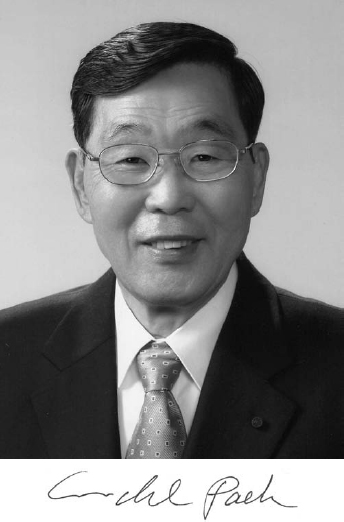1934–2011
Elected in 1998
“For the practical production of optical fibers.”
BY AUDREY PAEK
SUBMITTED BY THE NAE HOME SECRETARY
UN-CHUL PAEK, a pioneer in fast optical fiber drawing technologies and a chaired professor and professor emeritus at the Gwangju Institute of Science and Technology (GIST), passed away on May 3, 2011, in Gwangju, South Korea.
He was born in Jinju City, Gyeongnam Province, in South Korea on December 2, 1934. A self-starter who loved learning about the world, he valued education as a path to a better life after enduring personal loss and hardship following the Korean War. In 1957 he received a B.S. in engineering from the Korea Merchant Marine Academy. Given his aptitude for math and his skills for complex problem solving, he was encouraged by a naval officer to apply for graduate studies in the United States. After returning to Korea to get married, he undertook graduate studies at the University of California at Berkeley, where he received an M.S. in mechanical engineering in 1965 and a Ph.D. in applied physics in 1969.
After Berkeley he returned to Korea to start a family. His only child, Audrey, was born in 1970. He then decided to move his family to the United States and joined AT&T Bell Laboratories in Princeton, New Jersey, where he worked from 1969 until 1991. Among his many accomplishments, he became a distinguished member of the technical staff and was named a Bell Labs fellow. Un-Chul Paek was a pioneer in fast
optical fiber drawing technologies, which enabled installation of today’s global fiber-optic networks. His primary research interests included fiber design for high-speed wavelength division multiplexing systems, specialty fiber fabrication and fiber devices, and large-capacity fiber production processes. His work included the development of a furnace for drawing fibers; techniques for high-speed drawing, cooling, and coating of these fibers; analysis and perfection of fusion splicing; and, ultimately, theory and design of clad lightguide fibers.
Un-Chul Paek later served as an adjunct professor at Rutgers University, from 1987 to 1993 before returning to Korea in 1991 to become executive vice president of the Korea Academy of Industrial Technology. Rather than pursue a position in the Korean government, he returned to academia to pursue his passion as a lifelong scholar, teacher, and mentor to the next generation of graduate research students. In 1994 he became dean of faculty and a professor with the information communications department at the Gwangju Institute of Science and Technology (GIST). He was then named director of the Research Center for Ultrafast Fiber-Optic Networks in 1995. From 2000 to 2006, he served as a chaired professor and professor emeritus at GIST.
Un-Chul Paek received many honors throughout his career for his technical achievements and publications. He was inducted as a member of the National Academy of Engineering in 1998 for the practical production of optical fibers. In recognition of his lifelong contribution to the development of science and technology, he received the National Order of Civil Merit—the Presidential Medal of Honor—from former South Korean President Dae-Jung Kim. He was also a fellow of the Optical Society of America, the American Ceramic Society, and the Institute of Electrical and Electronics Engineers, as well as a member of Sigma Xi and an associate member of the Third World Academy of Science.
His thirst for knowledge, his personal diligence and devotion to research, and his mentorship of students and colleagues were hallmarks of his career. He believed in creating a life of meaning through service. Most people will remember him as a
brilliant scientist, collaborator, and educator, who pushed not only the boundaries of one’s intellect but also the boundaries of what was possible in science and technology to positively impact society. To his family and friends, he will always be known as the consummate gentleman, devoted husband, and loving father who had great integrity, wit, and an appreciation for storytelling with amazing recollection of historical facts and an understanding of diverse cultures and languages. He will continue to live in the hearts and memories of those he personally touched in meaningful ways.
Un-Chul is survived by his beloved wife of 49 years, Lee; his daughter, Audrey, and son-in-law Frank; his two younger brothers, Woon-Soo (Paul) and Woon-Seo and their families; his nephew Sang Hoon and his wife Kyung Sook; and his great-nephew Yoonha (James).





